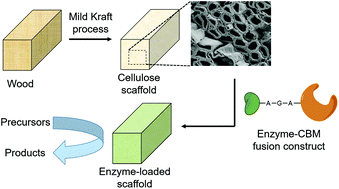Enzyme immobilisation on wood-derived cellulose scaffolds via carbohydrate-binding module fusion constructs†
Abstract
The development of cost-effective and green enzyme immobilisation techniques will facilitate the adoption of continuous flow biocatalysis (CFB) by industry and academia. In this work, a relatively mild sulfite pulping process was employed to remove lignin and hemicellulose from wood with minimal disruption of its native porous structure, resulting in aligned macroporous cellulosic monoliths termed cellulose scaffolds (CSs). By engineering carbohydrate-binding modules (CBMs) onto the termini of recombinant proteins, the CSs could be employed as low-cost, renewable and biodegradable materials for enzyme immobilisation without any further chemical functionalisation. CBM-tagged fluorescent proteins were initially employed to demonstrate proof-of-principle and to optimise immobilisation conditions; this resulted in initial protein loadings as high as 5.24 wt% and immobilisation efficiencies as high as 97.1%. The process was then translated to a CBM-tagged ω-transaminase (ωTA) from Bacillus megaterium, obtaining enzyme loadings and immobilisation efficiencies as high as 3.99 wt% and 82.4%, respectively. A demonstrative CFB reaction with the immobilised CBM-tagged ωTA displayed ca. 95 ± 5% conversion efficiency relative to the free enzyme in solution under analogous conditions, suggesting that CBM-tagged recombinant enzymes immobilised on wood-derived CSs could potentially compete with other, more complex and costly enzyme immobilisation technologies.

- This article is part of the themed collection: 2021 Green Chemistry Hot Articles


 Please wait while we load your content...
Please wait while we load your content...